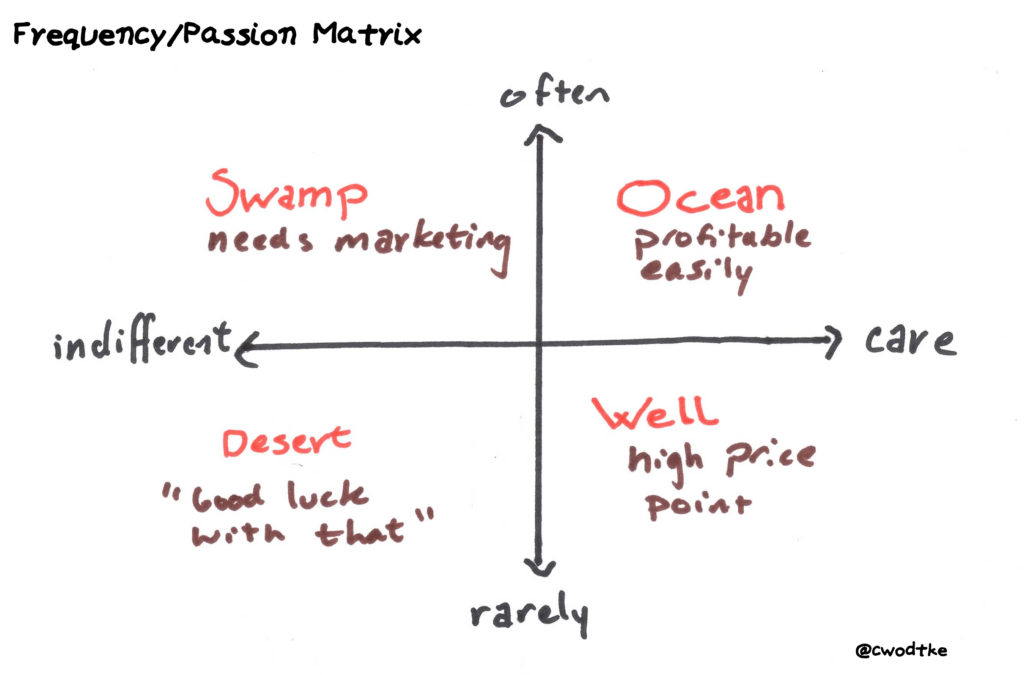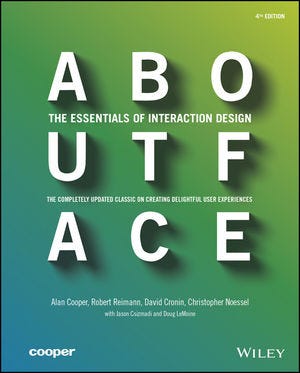There are three thinking styles that have transformed how we develop new products today: Agile, Lean (Startup) and Design Thinking. Design Thinking is the least defined and most problematic to explain. Agile gets engineering to work iteratively in cadences rather than invest in a lot of upfront planning, only to execute a plan that may be wrong. Lean (Startup) is about running constant business experiments whose outcomes reduce risk.
Design Thinking is often explained in a tautological fashion: it’s how designers think. But what makes this different than ordinary thinking, or Agile or Lean approaches? I believe what makes design thinking special is the “go wide, narrow, go wide, narrow” rhythm. It generates the broadest possibilities which leads to new solutions.
<draft> Design thinking is the practice of exploring research and ideas widely, narrowing insights down to likely solution candidates, then testing and generating still more wide and weird possibilities until something viable and innovative is discovered. </draft>

Design Thinking is not the fastest way to innovate; it is the most effective way. Move fast and break things is tired; move smart and make things better is wired. (see meme.)
As someone who has been educating designers for years now, I can attest that design thinking doesn’t come naturally — not even for designers. When I taught at CCA, I learned that sophomores majoring in interaction design didn’t work like designers at all. They’d do some research, get excited about something someone said, prototype it in some software program and show it to me, with the same look my cat gives me when he brings in a dead mouse.
Design thinking is not something you are born with. When those students become juniors, after hours of practice, some of them started to attack problems in a designerly way. By the time they were seniors, most of them used design thinking approaches, though some still backslid into how most people approach problems. Some never got it at all.
Consider that. After hours and hours of deliberate practice over years some people still cannot step into design thinking. Changing habits is hard.
Now let’s look at how design thinking is often taught: in boot camps and one day workshops. That’s design theater, not design thinking.
It’s not enough to say, look there is a better way! It takes practice. Lots of practice.
If you do think fondly of the magic you experienced over one of those one day workshops, here is a list of five design thinking methods you can practice in order to internalize design thinking. Do them often enough, and they will become habits that will transform your work. For realsies.

1. An Interview Is a Conversation
The core skill of research is interviewing. If you cannot ask effective questions about your products and services, you cannot get the information you need to succeed.
How we do it instinctively: We write down a series of questions, then we act like a survey form. i.e. we ask the folks we’re interviewing the questions, get their answers and we are done. I see this in students and clients both.
How we do it the Design Thinking way: treat an interview as a conversation. There are a dozen little things you need to learn about interviewing (a books worth,) but the biggest and more common mistake is not listening to the speaker and following up. Think about it for two seconds: what is the one thing you can do that a survey can’t? Ask follow up questions. And in those follow up questions entire universes of knowledge lie.
Q: Do you use kanban-style software, such as Trello or Asana?
Interviewee: No.
That’s the end if it’s a survey. You never learn anything else.
But if you are a human, you can say: Tell me more?
And you may learn many things. You may learn the interviewee has never heard of any of the things you listed. You may learn they have heard of them, but don’t understand their value. You may learn that current tools aren’t meeting real needs, and the interviewee has decided to “just use Google docs.” You can learn so much just by nodding, saying “hmmm?” and “Can you say more?”
Bonus trick: Use a topic map instead of a script. It can help you from just reading your interview script out loud.

Jargon: Needfinding
2. Inhabit the Data
Now we’ve gotten a whole bunch data from our interviews, how are we going to make sense of it all?
How we do it instinctively: We read through it, maybe highlight some of it, and then write down what resonates. Boo! So much bias!
How we do it the Design Thinking way: Put all interesting insights into a modular format, such as post-it notes. Sort them using an emergent classification scheme, based how patterns you discover (often called affinity grouping.) Now look at frequency of certain themes. Use this to either build a report, or do more research.

Bonus Trick: Sort your data based on multiple factors, including time and a 2×2 criteria such as frequency/passion. See Needfinding for Disruptive Innovation for the approach.
By rearranging the modular insights, you will discover new information. You have to coax every bit of insight out of the research if you truly wish to innovate beyond the obvious.
Jargon: Sensemaking.
We spend a lot of time talking about needfinding, but not enough talking about sensemaking. What is one without the other?
3. Get Wide and Weird
Now that we understand our research, it’s time to come up with some ideas of things to make.
How we do it instinctively: We go for a long walk, take a hot shower, etc etc and think. We think a lot. Then we have an idea we like, and we start to develop that. Yay.

How we do it the Design Thinking way: Whether it’s Crazy 8’s, 30 thumbnails or good old-fashioned Freelisting, designers get to quality via quantity. You start coming up with ideas. You don’t dismiss them, you write them down, as many as possible. when you hit the wall, you keep going. There is a moment when you think you are out, but if you push yourself, you start coming up with more ideas, ideas no one has heard of. Weird ideas. Sometimes interesting new ones. Sometimes merely dreadful ones. But this is where innovation has a shot of showing up.
Bonus trick: Bad idea brainstorming. Instead of thinking up good ideas, you try to think up the worst ideas. It’s ONE DUMB TRICK that an help you get out of a rut of the obvious. Learn more:
See also https://www.interaction-design.org/literature/topics/worst-possible-idea
Jargon: Ideation. It’s a process, not a one-time event.
4. Critique, not Criticism
A designer comes up with a potential direction for something. They show it to you. You say things. What do you say?
How we do it instinctively: You look, you think, you say what you feel. “I don’t like that blue” “Are you sure people will know what do to here?” “You should use a hamburger menu, it takes up less space” “Facebook does it this way, can’t we just copy them.”
How we do it the Design Thinking way: First we work to understand what the designer is trying to do, then we work through what strategies they are using, and finally we try to build on it with ideas to make it even better. In other words, we aren’t offering criticism about what’s wrong with the design; we are actively partnering with the designer from our area of expertise to make the design better. Our expertise may be as broad as being a fellow designer, or it may be as narrow as just being a user of software. Work from where you are. If you are an engineer, consider how it might be implemented, if you are a Product Manager, ask how it will convert… you are allowed to have opinions about color and type, of course, but is that the highest value way you can help the work reach its potential? What is really valuable is your insight from your area of expertise.
I spent some time trying to find a way to make it memorable for you, and this is what I’ve got: GASP.
- Goals. What is the purpose of this work?
- Attempts: what has the designer tried to do?
- Successes: where is the design effective at meeting the goal?
- Possibilities: Do you know anything that could make this design better?
So look at someone’s design and GASP (you can clutch your pearls while you do it.)

Bonus Trick: Experienced designers tell people what kind of feedback they want. A working designer knows to direct the feedback in order to get something usable. “What do you think?” is death to productivity.
One trick I really love is Laura Klein’s 20/80 feedback (not to be confused with Pareto’s Principal.) When the design is 20% done, you can tell people they are climbing the wrong mountain. When it’s 80% done, you can critique their style: fonts, language, color, etc. If you’ve got something you are offering up for critique, make sure you let people know what you are willing to change and what is off limits. Otherwise expect to be weeping in the bathroom later.
Jargon: Critique
5. Iterate with Your Target Market
Time to get more feedback on the wonderful thing you just thought up, this time with the people who have no expertise except life. In many ways, this is just 1+2+3+4. Ready?
How we do it instinctively: Show it to someone in accounting or some such who is kinda like our audience, and see what they think. Or, if you read Lean Startup (or skimmed it. or read a book review of it) you might Get Out of the Building and show it to an actual potential customer!
How we do it the Design Thinking way: Look at point #1. Make a topic map of all your concerns, and see if you can cover them all.
Point #2: Inhabit the data you collect.
Point #3: Generate a LOT of potential solutions for any issues that arise.
Point #4: Get your team to make you smarter

As my pal Abby Covert says, “How you do anything is how you do everything.” Work to internalize these habits, and you will find everything you do is more effective, from writing talks to pitching VC. EVERYTHING GETS BETTER! How cool is that?
Jargon: Design sprint, or if you really really want to be designerly, call it a charette.
Design Thinking & Design Doing
Finally, while Design Thinking is all nifty pancakes and all, doing design is an entire craft and it’s a SO important to learn to do it right if you want to make things that are not just innovative but good. User experience research, information architecture, interaction design, interface design are all large bodies of knowledge with entire books written about them — and that’s just a few of the skills we need to make good software.
Design Thinking is a better way to approach innovation in problem solving, but that is never enough to make products and services that succeed. Let’s say you have mastered the five habits. You still would want to understand how to organize information in order to provide effective retrieval and use. You still need to understand how to build intuitable flows. You still need to make interfaces that tell the story of the software’s power, and teaches the dangers of abuse. You still want (as Facebook and many others have learned) to figure out how you software changes the ecosystem it lives within, and if those second order effects are going to have you called before congress.
The Design Thinking process is powerful. It can be used in many scenarios beyond designing things, from working through treaties to inventing new business models. But if you are using it to make “disruptive” change, consider all the knowledge you need to make sure you aren’t disrupting the wrong things, and that you are actually offering something better than what people already have.
Don’t get so caught up in design thinking you forget to actually design.
Booklist, if you actually want to learn to design digital stuff rather than just think about it





Finally, design thinking is always better with some Visual Thinking, don’t you think?

Two days later
0. Pick the Right Problem
Thanks to a conversation with Abi Jones right after I wrote this, I feel like I need to add one more habit. People who have internalized Design Thinking spend more time than most on making sure they’ve got the right problem/opportunity statement before kicking off a project.

How we do it instinctively: We trust the obvious. We see something: dropping sales, a new competitor, a difficult workflow and we assume we know what the problems is: sales are dropping! Amazon is entering our market! We need a wearable! And then we go off into a flurry of activity.
How we do it the Design Thinking way: While a single event can trigger a design effort, design thinkers will stop and question everything… sometimes to the annoyance of their teammates. But asking why five times, doing maps of the ecosystem, seeking previous research, doing competitive analysis and generally understanding the context before diving into the commitment of a project is just plain smart. Then you’ll spend time wordsmithing the language of the project goal in order to keep possibilities open. “How might we” is favored by IDEO, but there are many ways to shape the call to design.
Bonus Trick: Consider developing your own canvas for everything you’d like to cover.
